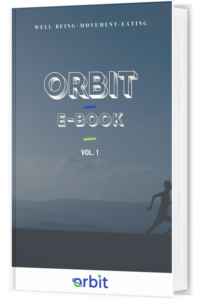Learning how to feel your fullness signifies that you are being mindful to your body’s signals indicating that you are no longer hungry.
Intuitive Eating1 is a book, created by Evelyn Tribole and Elyse Resch, that presents 10 principles to create a healthy relationship with your food, body, and mind. The 10 principles build upon one another. Work on every principle one by one. If you have not read the Principle #1, Principle #2, Principle #3, or #4, please refer to it before getting into this article.
The Key to Feel your Fullness1
The key is Principle #3: Making Peace with Food. If you do not give yourself unconditional permission to eat, you will have trouble respecting your fullness. For example, if you only give yourself permission to eat chocolate once a week, you might ignore your fullness cues, as you want to enjoy the chocolate as much as possible before it disappears.
Comfortable Fullness1
Think of a moment in which you felt you had eaten just enough food, without feeling stuffed. What are the physical sensations?
It may be hard to describe these sensations. For some, it is much easier to describe that feeling of being overly stuffed, than it is to describe the feeling of comfortable fullness.
It is easy to ignore our feelings of fullness when we are so focused on simply finishing our plate. Many of us have created an autopilot habit of finishing our plate. We don’t even think about how our body might feel within this rush to finish. This is the clean plate mentality. To shift away from this mentality, we must become hyper aware of what we are eating, rather than how much is left on our plate.
Tips to Help You Become More Aware While Eating1
Noticing the shift of being hungry to being satisfied is called conscious eating, according to Resch and Tribole (2012). The Food Anthropologist is an important part of this process, and it will observe your eating experience without judgement.
1. Before Eating: Identify your hunger level
Making sure you are hungry before you start eating will help you feel your fullness.
Also, making sure you are not ravenous when you start eating will also help in feeling your fullness. The more you are hungry when you start eating, the more likely it is to overeat. Try to not let your hunger drop to a 1, or 2 on the hunger/fullness scale.

2. During Meal: Put your fork down every few bites
Take a pause as you eat. This pause does not signify you will stop eating. It is simply a commitment to checking in with yourself. The hunger fullness scale will be an essential piece to this pause.
- How does the food taste, smell, look?
- What is the texture?
- Do you like it?
- Where are you at on the hunger/fullness scale.
3. When You are Done: Ask Yourself
Where are you at on the hunger/fullness scale? Try to aim for a 6, or 7 to reach that optimal comfortably satisfied level.
If you are higher than a 6, or 7, let the Food Anthropologist do its job. Note, non-judgmentally, how you feel. Getting to know your signals takes practice and comes with time.
Remember: You do not HAVE to leave food on the plate
Understanding that you do not have to finish your plate, also comes with understanding that you can finish your plate. If you have checked in with yourself as you ate, and you are still hungry, or not yet satisfied: By all means, finish your plate!
These recommendations are not rules. There is no such thing as “breaking them” or “failing”.
Increasing Conscious Eating1,2,3,4
1. Eat Without Distractions
- Turn off the TV, shut your computer, switch off your phone.
Have you ever watched TV while eating dinner, and after having finished noticed that you do not remember how your dinner tasted?
Research has shown that activities such as, television viewing, listening to music, listening to a podcast, playing a computer game distracts us from eating. In addition to distracting us, we eat more than if we were not distracted. One study found that participants who were eating in front of the television ate more than participants who were not, despite having similar ratings of hunger before the meal.
In addition, research has shown that multi-tasking is less efficient, as the brain must divide its resources. Let us take the example of somebody who keeps working on their computer while eating lunch. This person is likely to ignore his/her fullness IN ADDITION to producing reduced quality work than if she/he had taken 15 minutes to eat.
2. Last Bite
- Make a conscious decision to stop.
Identify an endpoint to your meal. Make a conscious effort to identify that this is the last bite of the meal. Remember, that you should be satisfied, and ready to stop when you decide to stop.
You can also use other tricks, such as putting a napkin over your plate, or pushing your plate forward. This allows your brain to mentally note that you are done eating.
3. Defend Yourself from Obligatory Eating
- Learn to say an assertive “No thank you” to the Left-Over Haters
Remember that if somebody nudges you to taste a food that she/he made, you do not have to say yes. Just because it is somebody else than yourself that made the food, it does not mean you should not check in with yourself to see whether you are still hungry.
The Rebel Ally might come in handy if somebody is pressuring you to eat or drink something.
Factors that Influence Fullness
1. Time
- How much time since your last meal/snack?
- Long periods of time between meals can cause your blood sugar levels to diminish, causing a release of a stress hormone, in addition to feeling ravenous, which often leads to overeating.
2. Type of Foods
- If you notice that you are often hungry, take note of the foods you eat: Are there healthy fats (seeds, nuts)? Protein (chicken, tofu), and are there fibers (whole grains, fruits, veggies)? Eating a meal with this combo will help you feel satiated for longer, in addition to feeling satisfied.
- If you are consuming, rapidly absorbed carbohydrates, such as candy or Gatorade will not keep you satiated for long. Unless you are doing high intensity endurance exercise for longer than 60 minutes, these types of carbs will not do much to keep you full.
3. Social Influences5
- Have you ever noticed that you eat differently when you are in a large group?
- Research has shown that the more people at a gathering, the more they tend to eat, for extended periods of times. Contrarily, calorie restrictive dieters, tend to under eat during social gathering out of fear of judgement, unless they “blow their diet”, in which case overeating occurs.




